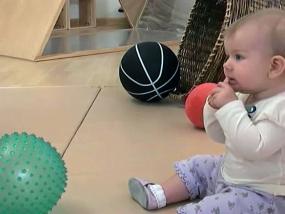What Infants Learn by Watching

We often think that touch, taste, and feel give the infant the information needed to distinguish the real from the not real, say a photograph of a ball versus a three dimensional sphere. The photograph looks like a ball, but you can’t pick it up or throw it, so it is not a real ball. For the moment, let’s think about the importance of looking, which after all creates the wonder in the first place. What is this thing I see? If the infant wonders, then the touch, heft, and taste serve to answer the question, as opposed to creating the question. Sometimes the answer comes from more looking. What is the thing that I see? Is it friendly? If I smile, will it smile back? If it rolls a little, will it continue to roll to there? Perhaps we need to add “eyes on learning” to our rather overused phrase “hands on learning.” Indeed, because infants cannot reach most of the interesting things that they see, they have built-in ways of learning by pure observation.
Watch this video and think about these questions: What might the several infants in this video be learning from watching? What questions does watching arouse? What answers does more watching provide? And where in the video might touching after looking create more questions?
Here are few examples to get you started. Notice how the infant at 00:48 changes from a smile to a more serious look when he realizes his right hand is holding something really wiggly. It turns out it is his own left hand. He saw something wiggly in his right hand, and that sight made him test his ability to make that funny object wiggle, that is, to test if the wiggling object was “him.” At 01:44 a ball bounces off his leg. An inaccurate attempt to pick it up causes two balls to roll away; the red one far, the yellow one a little before stopping. He visually judges that the red ball is too far and wonders if the yellow ball is still within his reach. He leans forward to pick it up. Seeing the movement no doubt creates the interest both to make the distance judgment and to pick up the closer ball.
Perhaps the most interesting segment comes at the end of this video, albeit there are wonderful segments all through these 4.5 minutes. Start watching around 04:12. The boy sees the teacher (off camera taking the video) in the mirrored wall and approaches this image. He continues to look at the teacher’s image in the mirror (check his line of gaze back to the camera). He does not seem that interested in his own image (research finds this typical, given that infants see their teacher’s face more often than their own). At 04:28 he starts to fret. Why? Could it be that the mirror, to him, felts like a glass barrier that prevents him from moving toward his teacher (the image)? Notice how he does turn to look at the real teacher when she starts to talk. In this case we speculate that touching the mirror does not help, but actually creates more questions. Have fun with this video. It has many example of how infants learn.
Runtime: 4 minutes 35 seconds
